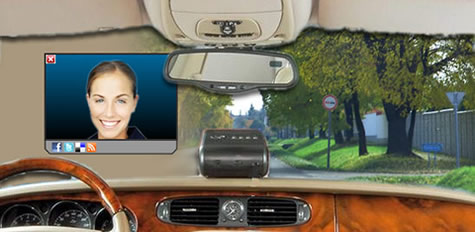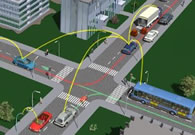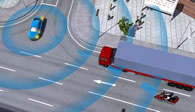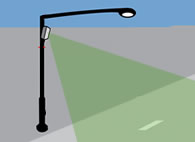
The Route Identification Detection Enhancer, or RIDE, is a state of the art, autonomous vehicle network. The system is composed of Route Identification Nodes (receiver/transmitters) and Detection Enhancer sensors for vehicles. Route Identification Nodes provide geographical and directional information for autonomous vehicles. These RI Nodes communicate with your vehicle providing a software update that gives your vehicle a direction to the next RI Node on your current route. Detection Enhancer systems will be equipped on vehicles and will allow them to interact with objects within their surroundings along their route from one RI Node to the next. These objects can range from other vehicles, to buildings, and even pedestrians.
While the driver can take full control of the vehicle at any point, the RIDE system provides a safe alternative. The DE sensors will be able to react faster than humans to potential threats. The system can be run fully autonomous or can run in the background as an assist to manual driving. The goal is to provide a safer environment where accidents will be a thing of the past.
The RIDE system also allows people to communicate with each other as they drive. The Wifi connection between all vehicles within signal range will help vehicles locate one another and act based on those locations, but the connectivity between vehicles also has an additional benefit: users can communicate with one another.
The benefits of this technology are many and varied. Route, media, and information sharing will be enhanced. Road tripping with family and extended family will never be the same. Any user within your RIDE system range can be contacted and invited for a video chat and/or accessed as an information/media source.

A system like this surely has cultural and global implications. What would the impact of such a system be on the world as we know it? Here are some potential implications of the widespread adoption of the RIDE system.
Environmental
The RIDE System will help the environment by saving gas on unnecessary speeding, stopping and starting. It is a commonly known fact that because of the constant starting and stopping involved in city driving, highway driving is more efficient. By allowing a more constant flow of traffic, the RIDE system helps to overcome this problem.
The utilization of the RIDE autonomous vehicle system would be beneficial towards maintaining road safety while driving. Cars will be able to interact with other cars and other nodes in order to determine their location as well as their distance to the destination. The most prominent environmental issue that could arise is that the system is too convenient, and would promote the use of automated vehicles more than ever before. People with access to this kind of technology would more likely use their own cars for transportation. This would most likely lead to a decrease in the use of public transportation and an increase in the net increase of gas emissions by individual cars. This would also lead to an increase in density of cars traveling on roads. The fact that one can afford their own transportation (paying only a one-time fee for the car and the cost of occasional refueling, rather than paying daily to take the subway or train) would make the personal use of cars more attractive to other people. This fact is tempered, however, by the increasing emergence of the use of alternative fuel sources for cars.
Legal
The new RIDE system, once perfected, will make many collisions and accidents a thing of the past because the detection enhancers will prevent cars from crashing. The main legal issue with the RIDE system is determining responsibility in the case of an accident. One of the best aspects of the RIDE system is its flexibility. The “driver” is free to assume control of the vehicle at any time, but when an accident occurs this creates a difficult situation. In case of an accident the authorities need to know who is to blame in order to make the proper charges. One solution to this is incorporating a sensor that records on impact whether the user or the vehicle is driving at the time of the crash. That alone would allow the police to narrow it down, with standard procedure applying if the user was in control at the time. If it is determined that the user was not in control of the vehicle at the time of the accident, a whole new set of procedures would have to be developed. The fault could rest with the car-maker, or the company that produces the sensors. The legal problems become complex because of the number of variables.
Social
The RIDE system will have many social benefits, including creating new jobs, revitalizing the joy and scenic nature of driving, and ending road rage. There will be extensive construction involved when this product is initially released. RI nodes will have to be set up throughout the country and DE sensors will have to be built and installed in cars. This will open up construction jobs for the first few years after the initial implementation of the system. Workers will then be needed to control and maintain the system. A team of engineers will be hired to make sure that the system is working efficiently. A large staff of experienced blue collar workers will be needed to maintain the system. Because the system operates on such a grand scale, repairs and adjustments will be made constantly. Road trips and other driving activities will become a much less stressful undertaking, and will motivate more people to go out and RIDE. Since more people will be using their cars, public transportation will become less crowded for those that still use it. By outfitting buses with the RIDE system, money could be saved on drivers.
With the RIDE system, people can interact with media and Internet while “driving” their cars. They can interact and talk via the SKYPE network and phones. The GPS would recommend places to go and people can use it for advertisements to help up-and-coming businesses, which would also help fund the constant cost of maintenance associated with the system. Public wifi will spread and become more common so people can use their laptops anywhere on the go. Car companies will create deals with internet companies and communication will be easier for people over wifi rather than over phone lines.
This system adds a whole new level of organization and maintenance to society. Traffic will be better controlled and delays would be shorter. Repairs and construction on roads will be less hazardous to other drivers and detours can be more easily mapped out and comprehended by the drivers. At the same time, the RIDE system will be able to collect and analyze highway data and use it to better serve the users of the system. This system will bring society to a much safer and much more organized level than it is today.
Safety
The impact that such a system would have on road safety would be incalculable; fatality rates would decrease and the danger would be removed from driving. One of the more fundamental principles in describing the safety of such a system is in the reaction time of a computer versus that of a human. There is no match for the computational and reactive speed of a computer. This in turn would eliminate all crashes that may have been avoided had the driver maneuvered differently. Computers have one advantage over humans in that they feel no emotions and so the fear of potentially striking another vehicle is absent, leaving that entity with a clear and focused objective; stay clear of the obstacle.
The pros of the RIDE system are that it detects and prevents auto accidents that are the main source of traffic and road problems in today’s society. This system’s analytical capabilities may also be used as a program to designate the condition of the people that are driving around you. This gives the system immense capabilities where it can designate to police and nearby drivers that they are driving next to an intoxicated driver, a driver who has a history of reckless driving and accidents, a criminal, or if a driver is falling asleep. If, somehow, there is an accident, it could immediately be communicated with emergency response forces, allowing for a faster reaction time (especially considering that they are coming in RIDE controlled vehicles). There aren’t many cons with this system’s safety capabilities except that people may reject the idea of being analyzed by a computer and claim that it is an infringement on their privacy.












